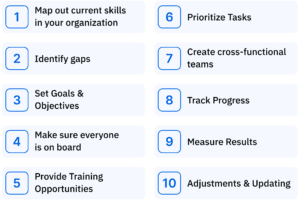How solution architects can utilize a skill matrix for efficiency
In this article, we discuss how solution architects can use a skill matrix for efficiency, highlighting its benefits and practical applications in their role.

As a solution architect, you’re constantly looking for ways to improve your team’s productivity and efficiency. However, it can be challenging to know where to start when it comes to developing your team’s skill set. First, you need to track down each team member’s skills, assess their strengths and weaknesses, and then develop a plan for future growth. Quite a task, but there’s a solution that could help you out. Let’s explore why a skill matrix software for solution architects is the best tool for tracking and managing the skills of each team member.
The benefits of a skills matrix for solution architects Copied

For solution architects, understanding and capitalizing on the benefits of a skills matrix is essential. A skills matrix is an organized chart that allows you to assess what skills are needed to complete a project effectively and quickly. Individual solution architects or teams can use it to ensure everyone involved has the necessary skill set to succeed. Let’s look at three benefits of using a skills matrix for solution architects.
1. Increased efficiency
A skills matrix helps increase efficiency by providing an easy-to-follow structure for assessing the skills needed for each task. With this structure in place, solution architects can quickly identify any missing or weak areas to develop strategies to address them. This saves time and money and reduces potential roadblocks in the project timeline.
2. Improved collaboration
A skills matrix also helps improve collaboration between team members by clearly outlining who has which skills and who needs additional training or advice. This ensures that everyone is on the same page and working towards the same goals, resulting in better collaboration between team members and, ultimately, more successful projects.
3. Enhanced visibility
Using a skills matrix also helps enhance visibility within the organization as it makes it easier for managers and other stakeholders to understand everyone’s capabilities and how those might be applied across multiple projects or initiatives. These enhanced insights lead to greater trust among team members, which can lead to improved performance overall.
What is skills matrix software?Copied
Skills matrix software is a tool that allows you to quickly and easily assess the skill level of any team member. By mapping out the skills required for each project, the software can help to identify gaps in knowledge and experience.
Additionally, the data from the software can be used to create development plans for individual team members, ensuring that everyone has the opportunity to learn the necessary skills. Skills matrix software is an essential tool for ensuring that teams are able to effectively collaborate and deliver high-quality performance.
10 tips for utilizing skill matrices for solution architectCopied

A skill matrix is an organized and efficient way to track your team’s skill set and help them develop a plan for future growth. Here are ten tips for getting the most out of your skill matrix as a solution architect.
1. Map out current skills in your organization
The first step in using a skill matrix is to map out the existing skills in your organization. This will give you an idea of who has what abilities and how those abilities can be utilized.
2. Identify gaps
If gaps exist in your team’s knowledge base, now is the time to identify them and plan accordingly so that those gaps can be filled before beginning work on the project (if applicable). This could mean hiring new employees or training existing ones in specific areas as needed.
3. Set goals and objectives
For each team member to reach their full potential you will need to set individual goals and objectives. Give each person something to strive for and provide direction regarding development and training sessions.
4. Make sure everyone is on board
When implementing a skill matrix is making sure everyone is on board with it. Your team should understand why the skill matrix is essential and how it will benefit everyone involved. Once everyone is clear on this, you can move forward with implementation.
5. Provide training opportunities
With access to training opportunities you will enable team members to take ownership of their development. You can help them increase their confidence in tackling new challenges by using the skill matrix. Quickly identify which members need additional training to become more influential in the team moving forward.

6. Prioritize tasks
The skill matrix makes it easy to prioritize tasks, based on each individual’s strengths or weaknesses in a particular area so that everyone works towards common goals together as efficiently as possible. This allows everyone on the team to work together towards success without unnecessary delays or confusion about who should take on which task first.
7. Create cross-functional teams
Cross-functional teams can benefit collaboration between departments or specializations, allowing members to learn from each other while creating more efficient solutions.
8. Track progress
To ensure everyone meets their objectives promptly you need to thoroughly evaluate growth. Utilizing the skill matrix can give you an overview of how well each individual performs and provide insight into what areas might need improvement or further development.
9. Measure results
The results achieved by each individual should be tracked regularly to determine how well they are performing against established objectives and goals, as well as being able to measure progress over time within both teams and individuals alike across different departments within an organization.
10. Adjustments and updating
As time passes, specific individuals may need additional training to stay up-to-date on industry trends or changes in technology. Regularly reflect on the analysis of this data in regards to their respective profiles within the skill matrix system. By doing so, you prevent surprises and keep track of the team’s wellbeing.
By utilizing these guidelines, solution architects can maximize their teams’ productivity while also helping them reach peak levels of efficiency through the successful utilization of skill matrices!
AG5 skills matrix for solution architectCopied
Access to an organized chart of your team’s skill sets is essential for any solution architect looking to maximize project performance and success rate. Many advantages of using a skills matrix make it invaluable for those working in this field.
AG5 skills matrix software provides a comprehensive and centralized view of an organization’s skills, knowledge and training requirements.
I would love to share the possibilities for customization to meet the specific needs of your organization. Stay ahead of the competition and try our software. Schedule your free live demo today!

